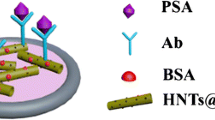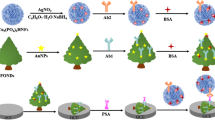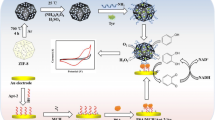Abstract
A sandwich-type electrochemical immunosensor was designed for the ultrasensitive detection of prostate-specific antigen (PSA), using Au nanoparticles (Au NPs) modified nitrogen-doped porous carbon (NPC) as sensor platform and trimetallic PdAgCu mesoporous nanospheres (PdAgCu MNSs) as enzyme-mimicking labels. NPC was prepared by a facile one-step pyrolysis strategy of biomimetic phylloid zeolite imidazole framework (ZIF-L) nanosheets. Through this strategy, the graphitization of the microcrystalline structure enhanced the electrical conductivity, while its enlarged specific surface area and abundant pore volume can enrich H2O2 to improve the catalytic efficiency. Moreover, Au NPs were used to modify NPC without cross-linking agents to further optimize electron transport while capturing primary antibodies, improving stability and sensitivity of the immunosensor. PdAgCu MNSs with uniform size, cylindrical open mesoporous channels, and continuous crystal frame structure were self-assembling synthesized by electrostatic adsorption and ascorbic acid (AA) co-reduction with amphiphilic dioctadecyldimethylammonium chloride (DODAC) as surfactant-cum-micelle, whose unique structure maximizes the use of polyatoms to expose catalytic sites, exhibiting good biocompatibility and electrocatalytic ability. Under the optimal conditions, the immunosensor showed superior sensitivity, a wide dynamic detection range (10 fg mL−1 ~ 100 ng mL−1) and a low limit of detection (LOD, 3.29 fg mL−1). This work provides a convenient strategy for the clinical detection of PSA.
Graphical abstract







Similar content being viewed by others
References
Wong MC, Goggins WB, Wang HH, Fung FD, Leung C, Wong SY, Ng CF, Sung JJ (2016) Global incidence and mortality for prostate cancer: analysis of temporal patterns and trends in 36 countries. Eur Urol 70(5):862–874
Bray F, Ferlay J, Soerjomataram I, Siegel RL, Torre LA, Jemal A (2018) Global cancer statistics 2018: GLOBOCAN estimates of incidence and mortality worldwide for 36 cancers in 185 countries. CA Cancer J Clin 68(6):394–424
Culp MB, Soerjomataram I, Efstathiou JA, Bray F, Jemal A (2020) Recent global patterns in prostate cancer incidence and mortality rates. Eur Urol 77(1):38–52
Zhang B, Wang H, Xi J, Zhao F, Zeng B (2019) A novel Z-scheme ZnIn2S4/WO3 photocatalyst based photoelectrochemical immunosensor for the sensitive detection of prostate specific antigen. Sens Actuators, B Chem 298:126835
Raina K, Lu J, Qian Y, Altieri M, Gordon D, Rossi AMK, Wang J, Chen X, Dong H, Siu K, Winkler JD, Crew AP, Crews CM, Coleman KG (2016) PROTAC-induced BET protein degradation as a therapy for castration-resistant prostate cancer. Proc Natl Acad Sci 113(26):7124–7129
Tang C, Wang P, Zhou K, Ren J, Wang S, Tang F, Li Y, Liu Q, Xue L (2022) Electrochemical immunosensor based on hollow porous Pt skin AgPt alloy/NGR as a dual signal amplification strategy for sensitive detection of neuron-specific enolase. Biosens Bioelectron 197:113779
Morris S, Cottrell M, Rawlings SA, Peterson S, Karris M, Pacheco D, Chaillon A, Kay A, Chow K, Anderson PL, Gianella S, Blumenthal J (2022) Genital inflammation is not associated with decreased vaginal tenofovir concentrations in women taking oral PrEP. JAIDS Journal of Acquired Immune Deficiency Syndromes 89(4):390–395
Yang Q, Wang P, Ma E, Yu H, Zhou K, Tang C, Ren J, Li Y, Liu Q, Dong Y (2021) A sandwich-type electrochemical immunosensor based on Au@Pd nanodendrite functionalized MoO2 nanosheet for highly sensitive detection of HBsAg. Bioelectrochemistry 138:107713
Feng S, Yan M, Xue Y, Huang J, Yang X (2021) Electrochemical immunosensor for cardiac troponin I detection based on covalent organic framework and enzyme-catalyzed signal amplification. Anal Chem 93(40):13572–13579
Yildiz G, Bolton-Warberg M, Awaja F (2021) Graphene and graphene oxide for bio-sensing: general properties and the effects of graphene ripples. Acta Biomater 131:62–79
Hu S, Munoz F, Noborikawa J, Haan J, Scudiero L, Ha S (2016) Carbon supported Pd-based bimetallic and trimetallic catalyst for formic acid electrochemical oxidation. Appl Catal B 180:758–765
Öndeş B, Evli S, Uygun M, AktaşUygun D (2021) Boron nitride nanosheet modified label-free electrochemical immunosensor for cancer antigen 125 detection. Biosensors and Bioelectronics 191:113454
Biswas S, Lan Q, Xie Y, Sun X, Wang Y (2021) Label-free electrochemical immunosensor for ultrasensitive detection of carbohydrate antigen 125 based on antibody-immobilized biocompatible MOF-808/CNT. ACS Appl Mater Interfaces 13(2):3295–3302
Tang D, Yang X, Wang B, Ding Y, Xu S, Liu J, Peng Y, Yu X, Su Z, Qin X (2021) One-step electrochemical growth of 2D/3D Zn(II)-MOF hybrid nanocomposites on an electrode and utilization of a PtNPs@2D MOF nanocatalyst for electrochemical immunoassay. ACS Appl Mater Interfaces 13(39):46225–46232
Hu Y, Dai L, Liu D, Du W, Wang Y (2018) Progress & prospect of metal-organic frameworks (MOFs) for enzyme immobilization (enzyme/MOFs). Renew Sustain Energy Rev 91:793–801
Gu Y, Wu Y-N, Li L, Chen W, Li F, Kitagawa S (2017) Controllable modular growth of hierarchical MOF-on-MOF architectures. Angew Chem Int Ed 56(49):15658–15662
Palakollu VN, Chen D, Tang J-N, Wang L, Liu C (2022) Recent advancements in metal-organic frameworks composites based electrochemical (bio)sensors. Microchim Acta 189(4):161
Wang C, Kim J, Tang J, Kim M, Lim H, Malgras V, You J, Xu Q, Li J, Yamauchi Y (2020) New strategies for novel MOF-derived carbon materials based on nanoarchitectures. Chem 6(1):19–40
Li W, Chen Z, Yu H, Li J, Liu S (2021) Light-emitting materials: wood-derived carbon materials and light-emitting materials. Adv Mater 33(28):2170212
Chen Q, Yuan C, He Z, Wang J, Zhai C, Bin D, Zhu M (2022) A label-free photoelectrochemical sensor of S, N co-doped graphene quantum dot (S, N-GQD)-modified electrode for ultrasensitive detection of bisphenol A. Microchim Acta 189(5):208
Gulbalkan HC, Haslak ZP, Altintas C, Uzun A, Keskin S (2022) Assessing CH4/N2 separation potential of MOFs, COFs, IL/MOF, MOF/polymer, and COF/polymer composites. Chem Eng J 428:131239
Jiang H-L, Liu B, Lan Y-Q, Kuratani K, Akita T, Shioyama H, Zong F, Xu Q (2011) From metal–organic framework to nanoporous carbon: toward a very high surface area and hydrogen uptake. J Am Chem Soc 133(31):11854–11857
Zheng H, Yang S-J, Zheng Y-C, Cui Y, Zhang Z, Zhong J-Y, Zhou J (2020) Electrostatic effect of functional surfaces on the activity of adsorbed enzymes: simulations and experiments. ACS Appl Mater Interfaces 12(31):35676–35687
Ma E, Wang P, Yang Q, Yu H, Pei F, Zheng Y, Liu Q, Dong Y, Li Y (2020) Electrochemical immunosensors for sensitive detection of neuron-specific enolase based on small-size trimetallic Au@Pd^Pt nanocubes functionalized on ultrathin MnO2 nanosheets as Signal Labels. ACS Biomater Sci Eng 6(3):1418–1427
Iglesias-Mayor A, Amor-Gutierrez O, Novelli A, Fernandez-Sanchez MT, Costa-Garcia A, de la Escosura-Muniz A (2020) Bifunctional Au@Pt/Au core@shell nanoparticles as novel electrocatalytic tags in immunosensing: application for Alzheimer’s disease biomarker detection. Anal Chem 92(10):7209–7217
Dong H, Cao L, Zhao H, Liu S, Liu Q, Wang P, Xu Z, Wang S, Li Y, Zhao P, Li Y (2020) “Gold-plated″ IRMOF-3 and sea cucumber-like Pd@PtRh SNRs based sandwich-type immunosensor for dual-mode detection of PCT. Biosens Bioelectron 170:112667
Gawande MB, Ariga K, Yamauchi Y (2021) Single-atom catalysts. Small 17(16):2101584
Jeong H, Shin S, Lee H (2020) Heterogeneous atomic catalysts overcoming the limitations of single-atom catalysts. ACS Nano 14(11):14355–14374
Gong Y, Liu X, Gong Y, Wu D, Xu B, Bi L, Zhang LY, Zhao XS (2018) Synthesis of defect-rich palladium-tin alloy nanochain networks for formic acid oxidation. J Colloid Interface Sci 530:189–195
Liu D-X, Zhou Y-T, Zhu Y-F, Chen Z-Y, Yan J-M, Jiang Q (2022) Tri-metallic AuPdIr nanoalloy towards efficient hydrogen generation from formic acid. Appl Catal B 309:121228
Yu X, Li X, Zhang S, Jia Y, Xu Z, Li X, Chen Z, Li Y (2021) Ultrasensitive electrochemical detection of neuron-specific enolase based on spiny core-shell Au/CuxO@CeO2 nanocubes. Bioelectrochemistry 138:107693
Dong H, Liu S, Liu Q, Li Y, Li Y, Zhao Z (2022) A dual-signal output electrochemical immunosensor based on Au-MoS2/MOF catalytic cycle amplification strategy for neuron-specific enolase ultrasensitive detection. Biosens Bioelectron 195:113648
Fang Q, Lin Z, Lu F, Chen Y, Huang X, Gao W (2019) A sensitive electrochemiluminescence immunosensor for the detection of PSA based on CdWS nanocrystals and Ag+@UIO-66-NH2 as a novel coreaction accelerator. Electrochim Acta 302:207–215
Wang P, Pei F, Ma E, Yang Q, Yu H, Liu J, Li Y, Liu Q, Dong Y, Zhu H (2020) The preparation of hollow AgPt@Pt core-shell nanoparticles loaded on polypyrrole nanosheet modified electrode and its application in immunosensor. Bioelectrochemistry 131:107352
Sun X, Li C, Zhu Q, Chen J, Li J, Ding H, Sang F, Kong L, Chen Z, Wei Q (2020) A novel ultrasensitive sandwich-type photoelectrochemical immunoassay for PSA detection based on dual inhibition effect of Au/MWCNTs nanohybrids on N-GQDs/CdS QDs dual sensitized urchin-like TiO2. Electrochim Acta 333:135480
Zhang M, Hu X, Mei L, Zhang L, Wang X, Liao X, Qiao X, Hong C (2021) PSA detection electrochemical immunosensor based on MOF-235 nanomaterial adsorption aggregation signal amplification strategy. Microchem J 171:106870
Li B, Guo L, Chen M, Guo Y, Ge L, Kwok HF (2022) Single-atom Pt-anchored Zn0.5Cd0.5S boosted photoelectrochemical immunoassay of prostate-specific antigen. Biosensors and Bioelectronics 202:114006
Funding
This work was financially supported by the Natural Science Foundation of Shandong Provincial (ZR2021MB048, ZR2021QB050) and the National Key Scientific Instrument and Equipment Development Project of China (No. 21627809).
Author information
Authors and Affiliations
Corresponding authors
Ethics declarations
Conflict of interest
The authors declare no competing interests.
Additional information
Publisher's note
Springer Nature remains neutral with regard to jurisdictional claims in published maps and institutional affiliations.
Supplementary Information
Below is the link to the electronic supplementary material.
Rights and permissions
Springer Nature or its licensor holds exclusive rights to this article under a publishing agreement with the author(s) or other rightsholder(s); author self-archiving of the accepted manuscript version of this article is solely governed by the terms of such publishing agreement and applicable law.
About this article
Cite this article
Shang, Q., Dong, H., Liu, S. et al. Sandwich-type electrochemical immunosensor based on nitrogen-doped porous carbon and nanoporous trimetallic nanozyme (PdAgCu) for determination of prostate specific antigen. Microchim Acta 189, 359 (2022). https://doi.org/10.1007/s00604-022-05458-4
Received:
Accepted:
Published:
DOI: https://doi.org/10.1007/s00604-022-05458-4




